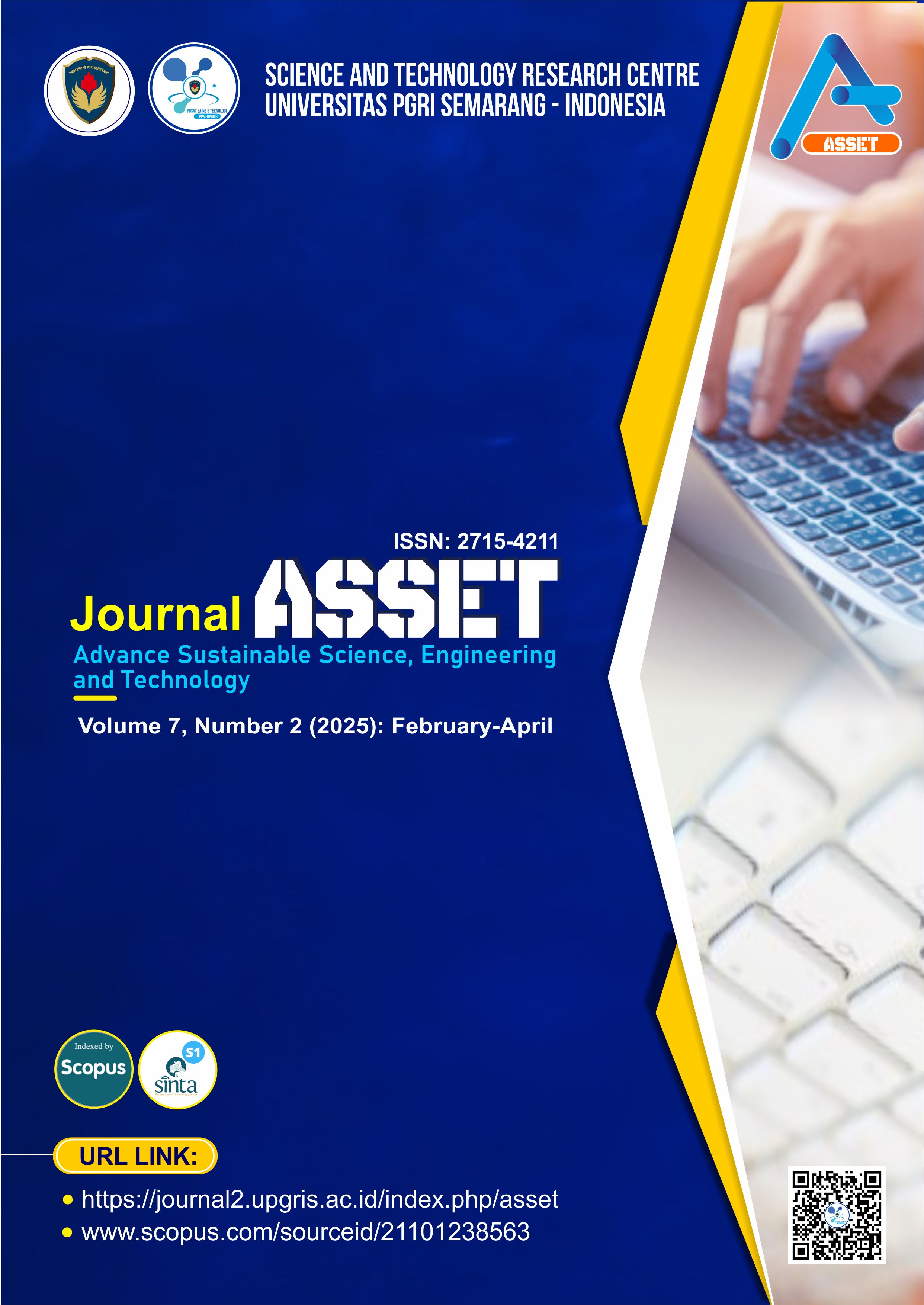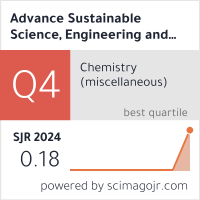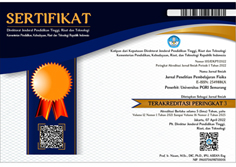Development of an Ultrasonic Surface Roughness Meter for Road Maintenance: A Prototype for IRI Measurement
DOI:
https://doi.org/10.26877/d057s113Keywords:
ultrasonic measurement, road infrastructure, pavement condition, road roughness measurement technologyAbstract
The importance of the road network in Indonesia as a vital infrastructure that connects various regions has made road maintenance a top priority in development planning. However, various challenges such as ineffective handling methods, limited experts, and minimal equipment have caused road management to not be optimal. Therefore, innovations are needed in road condition measurement, one of which is through the development of an ultrasonic sensor-based surface roughness measuring instrument as a prototype of International Roughness Index (IRI) measurement to support more accurate road maintenance evaluation and planning. The purpose of this research is to measure road roughness through IRI and pavement modulus values to improve road condition assessment.This study employs the International Roughness Index (IRI) to assess the functional condition of roads and the Pavement Modulus to evaluate the structural strength of the pavement. The IRI is measured through road surface roughness surveys using a roughness meter, with the results used to classify the severity of road damage. The IRI calculation is based on a quarter-car simulation model that utilizes vehicle dynamic parameters in response to road surface profiles, following the mathematical approach developed by Sayers, Gillespie, and Paterson (1986). The research results show that the prototype Ultrasonic Surface Roughness Meter was able to measure IRI values ranging from 4 to 8 at three different locations. These measurements fall within the "Good–Fair" classification, indicating relatively mild surface roughness. Based on these findings, the Directorate General of Highways recommends light rehabilitation and periodic maintenance, and the prototype device has the potential to serve as an effective, low-cost alternative for road condition monitoring, especially in areas with limited access to conventional IRI measurement tools.
References
[1] P. F. Dewi and Z. R. Kamandang, “Optimizing Project Performance by Applying the Crashing Method to Road Construction Project,” Adv. Sustain. Sci. Eng. Technol, vol. 5, no. 2, p. 0230203, 2023.
[2] E. D. Pulungan, “From Archipelago to Maritime Hub: Indonesia’s Quest to Become the World’s New Maritime Axis,” Jurnal Ilmiah Ilmu Sosial, vol. 10, no. 2, pp. 106–117, 2024.
[3] P. Sadeghi and A. Goli, “Investigating the impact of pavement condition and weather characteristics on road accidents,” International Journal of Crashworthiness, vol. 29, no. 6, pp. 973–989, 2024.
[4] K. Mbiyana, M. Kans, J. Campos, and L. Håkansson, “Literature review on gravel road maintenance: current state and directions for future research,” Transp Res Rec, vol. 2677, no. 5, pp. 506–522, 2023.
[5] P. Pratikso, A. Purwanto, and S. Sudarno, “Analysis influence of cement of the asphalt pavement demolition material on roads Semarang-Demak-Indonesia,” Journal of Urban and Environmental Engineering, vol. 11, no. 1, pp. 73–78, 2017.
[6] D. Astm, “1141-98:‘Standard Practice for the Preparation of Substitute Ocean Water,’” American Society for Testing and Materials, USA, 1998.
[7] Iriyanto and Reny Rahmawati, “Study on Road Damage Londis Assessment with the International Roughness Index (IRI) and Surface Distress Index 9sdi Value Method) (Case Study of Waena Alternative Road _ Entrop),” Jurnal, vol. 13, no. 2, pp. 2589–8891, 2020.
[8] Novena Octaviani Kusuma Dewi, “Evaluation of the Level of Road Unevenness Based on IRI Values using the NAASRA Test Method (Case Study of Regency Roads in Ngaglik Sleman District),” Atma Jaya University, 2021.
[9] Diar Kurnia Sari, Ary Setyawan, and Suryoto, “Analysis of Road Functional Condition with PSI and RCI Methods and Prediction of the Remaining Life of Road Pavement Case Study: Jalan Milir – Sentolo,” e-Jurnal MATRIKS TEKNIK SIPIL, vol. 6, no. 1, pp. 120–132, 2018.
[10] A. Pranedya Usmany and T. Lie Ing, “Road Damage Rate Using the Pavement Condition Index Method and the Present Serviceability Index Method,” in Proceedings of the 19th International Symposium of FSTPT Islamic University of Indonesia, 2016, pp. 979–95721.
[11] U. Tho’atin, A. Setyawan, and M. Suprapto, “Penggunaan Metode International Roughness Index (Iri), Surface Distress Index (Sdi) Dan Pavement Condition Index (Pci) Untuk Penilaian Kondisi Jalan Di Kabupaten Wonogiri,” Prosiding Semnastek, 2016.
[12] A. G. Mahardika, T. Rachman, B. Nuryono, H. Fadriani, I. Hidayat, and G. D. Ramady, “Road Handling Using International Roughness Index and Surface Distress Index Method,” in Journal of Physics: Conference Series, IOP Publishing, 2021, p. 012087.
[13] E. Golov, S. Evtyukov, M. Protsuto, S. Evtyukov, and E. Sorokina, “Influence of the road surface roughness (according to the International Roughness Index) on road safety,” Transportation research procedia, vol. 63, pp. 999–1006, 2022.
[14] Director General of Highways and Ministry of Public Works, “Construction and Building Manual, Road Condition Survey for Routine Maintenance,” 2011.
[15] M. W. Sayers, T. D. Gillespie, and W. D. O. Paterson, “Guidelines for conducting and calibrating road roughness measurements,” University of Michigan, Ann Arbor, Transportation Research Institute, 1986.
[16] M. W. Sayers, “On the calculation of international roughness index from longitudinal road profile,” Transp Res Rec, no. 1501, 1995.
[17] S.-L. Chen, C.-H. Lin, C.-W. Tang, L.-P. Chu, and C.-K. Cheng, “Research on the international roughness index threshold of road rehabilitation in metropolitan areas: A case study in Taipei city,” Sustainability, vol. 12, no. 24, p. 10536, 2020.
[18] M. W. Sayers, T. D. Gillespie, and W. D. O. Paterson, “Guidelines for conducting and calibrating road roughness measurements,” University of Michigan, Ann Arbor, Transportation Research Institute, 1986.
[19] K. Asghari, “Evaluating Sensor Technologies for Use in Asphalt Pavement Engineering,” Skripsi Sarjana, University of Twente, 2025.
[20] M. Abdallah, C. M. Clevenger, S. Monghasemi, and M.-P. Consortium, “Studying the Use of Low-Cost Sensing Devices to Report Roadway Pavement Conditions,” Mountain-Plains Consortium, 2024.
[21] J. C. P. Pratama, “Tinjauan Literatur Tentang Kecerdasan Buatan Sebagai Pendekatan Dalam Pengendalian Sistem Lalu Lintas,” Jurnal Infrastruktur, vol. 7, no. 1, pp. 61–69, 2021.











